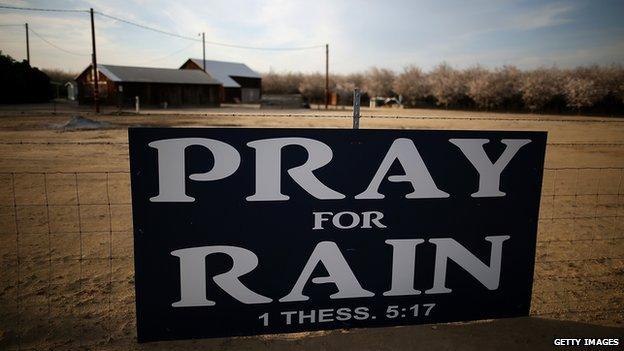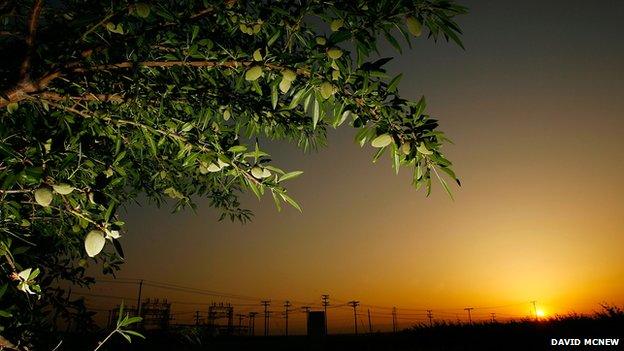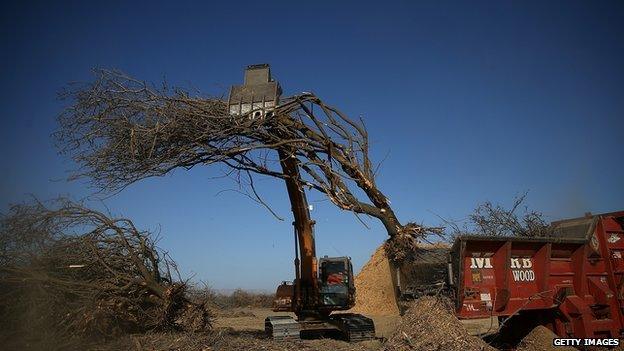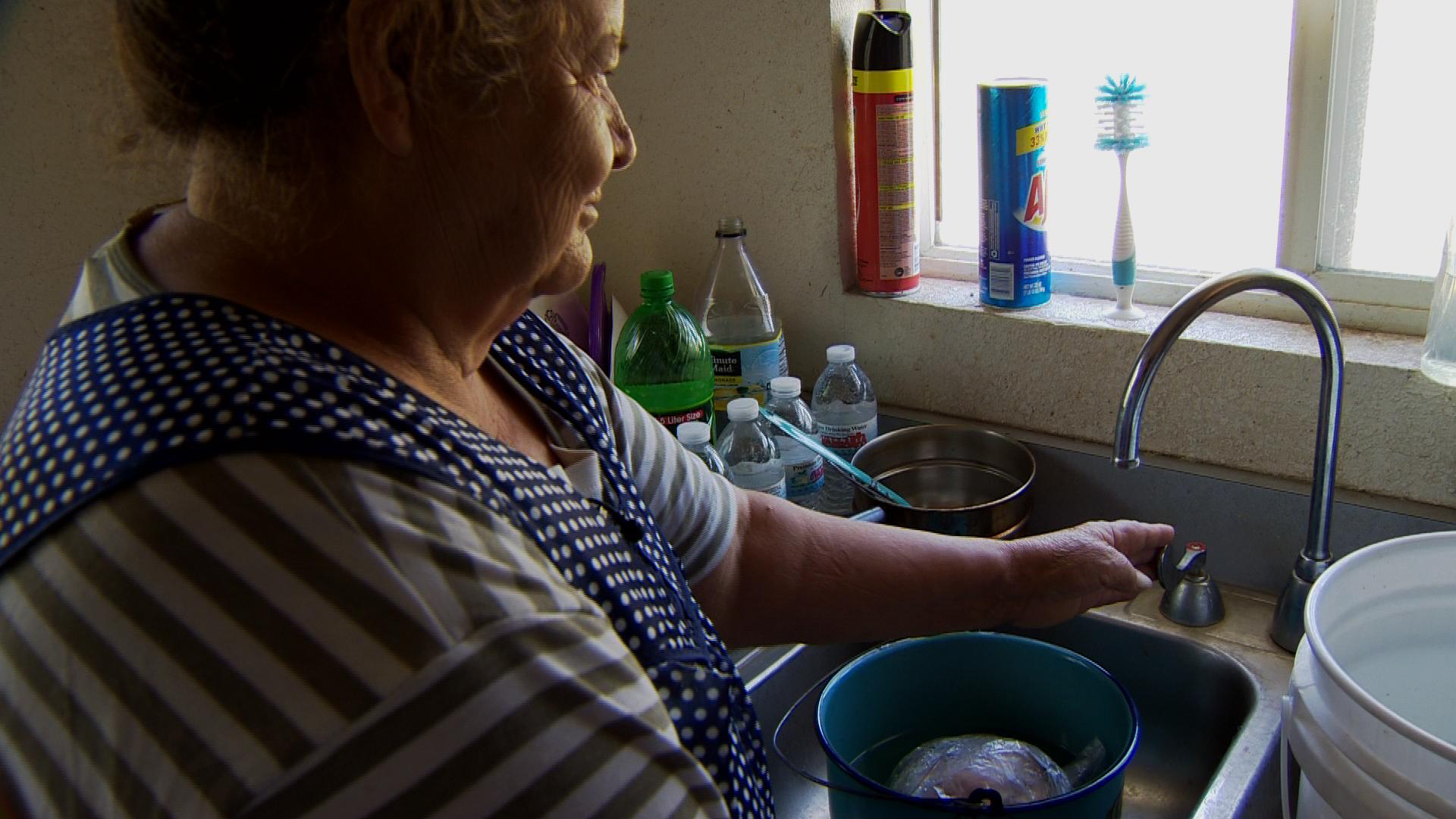How almonds are sucking California dry
- Published

California's worst drought for more than a century is causing huge problems for farmers, who need a trillion gallons of water per year for their almond orchards alone. But it also leaves homeowners facing difficult choices about what to do with their lawn.
I have a neighbour, Deborah, and ever since I've lived here, her front lawn has been luxuriant and green.
But wandering by the other day I did a double take. Mounds of earth were piled up where the grass had once been, and an army of workmen had set about installing succulent plants and ground cover, and the kind of prickly cactus you normally see in children's cartoons.
By the time Deborah had finished explaining why she was doing it, I could hardly believe I hadn't done the same thing myself.
Aside from the satisfaction of knowing you are planting something that is actually meant to grow in these desert-like conditions - as opposed to grass, which sucks up water with the zeal of an inebriate who has stumbled upon the keys to the drinks cabinet - she also stands to save a fortune on her water bill.

Some homeowners and businesses are letting lawns die off and having them painted green
She even avoids having to confront a sorry, burned-out apology-for-a-front-lawn every time she leaves the house.
Added to which, the city of Los Angeles actually paid her to do it - generously too, by all accounts.
And if paying people to rip up their lawns and replace them with drought-tolerant plants strikes you as an odd use of government resources, then all I can say to you is that desperate times call for desperate measures - and these are desperate times.
California is now in its third year of drought. The reservoirs are running dry and so too are the ground water supplies.
While comedians joke that it's so dry in California these days that the longest lines at Disneyland are for the water fountains - or ponder replacing the bear on the California state flag with a camel - what this place is witnessing is a dust bowl of truly Steinbeckian proportions.
It's so dry, in fact, that officials were reportedly thinking of adding a fifth level to the current four-tiered drought scale, which currently rates 99% of the state as "abnormally dry".
But while replacing your lawn with plants does help save water, the vast majority of the water used here goes not to households but to support California's economic mainstay - agriculture.
So water-intensive is the industry that the benefits of planting the odd cactus here or there start to seem a little modest in comparison.
Take almonds. In recent recent years the little nut with the hard brown shell has been touted as the holy grail of healthy snacks. Whether you're seeking a slimmer body, or a smoother skin, or you just want to spend a little longer on the planet, almonds are for you.

California almonds are exported all over the world, including India
They've been touted as a remedy for cancer, arthritis, heart disease and even Alzheimer's. Not surprisingly, perhaps, given their growing fan base, the farmers of California's Central Valley have been planting them like there's no tomorrow.
Getting on for a million acres are now given over to almond trees, and such is the nurturing nature of California's Mediterranean climate that this state now accounts for more than 80% of the global supply.
The problem is that California's entire almond crop commands a stunning 1.1 trillion gallons of water every single year.

Almond trees require enormous amounts of water to thrive
That's twice as much as it takes to grow cotton or tomatoes, and enough - I am reliably informed - for you or me to take a 10-minute shower every day for the next 86 million years.
Added to which, it's not as if this nutty elixir is being produced to satisfy local demand. Nearly 70% of the almonds produced in California are for export. And where do most of them end up? China.
This does little to quell criticism that the Chinese - with their booming economy - may soon, quite literally, be sucking this place dry.
Predictably perhaps, there have been calls to scale back on almond farming - at least until the rains return.

Due to a lack of water, some farmers have decided to shred some of their almond tree
As for those front lawns, my neighbour Deborah may have started a trend. Now that weekly watering restrictions have been introduced, others in the street are considering cashing in and planting cactus and succulents instead.
In the meantime, "brown is the new green" around here. I have to admit, however, it's painfully difficult to stop watering your grass.
Hence the "dawn chorus" in these parts is not so much the sound of birdsong, as the subtle hiss of sprinkler systems engaging in a furtive nocturnal ritual.
Judging by how lush some of the lawns are around here one might almost be tempted to think some are bending the rules. "Almost" being the operative word - I have to live here, after all.
How to listen to From Our Own Correspondent, external:
BBC Radio 4: Saturdays at 11:30
Listen online or download the podcast.
BBC World Service: Short editions Monday-Friday - see World Service programme schedule.
Subscribe to the BBC News Magazine's email newsletter to get articles sent to your inbox.
- Published27 August 2014

- Published27 August 2014
